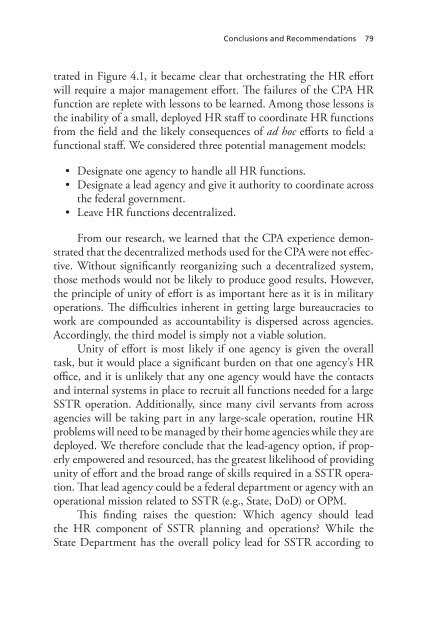Stabilization and Reconstruction Staffing - RAND Corporation
Stabilization and Reconstruction Staffing - RAND Corporation
Stabilization and Reconstruction Staffing - RAND Corporation
You also want an ePaper? Increase the reach of your titles
YUMPU automatically turns print PDFs into web optimized ePapers that Google loves.
Conclusions <strong>and</strong> Recommendations 79trated in Figure 4.1, it became clear that orchestrating the HR effortwill require a major management effort. The failures of the CPA HRfunction are replete with lessons to be learned. Among those lessons isthe inability of a small, deployed HR staff to coordinate HR functionsfrom the field <strong>and</strong> the likely consequences of ad hoc efforts to field afunctional staff. We considered three potential management models:•••Designate one agency to h<strong>and</strong>le all HR functions.Designate a lead agency <strong>and</strong> give it authority to coordinate acrossthe federal government.Leave HR functions decentralized.From our research, we learned that the CPA experience demonstratedthat the decentralized methods used for the CPA were not effective.Without significantly reorganizing such a decentralized system,those methods would not be likely to produce good results. However,the principle of unity of effort is as important here as it is in militaryoperations. The difficulties inherent in getting large bureaucracies towork are compounded as accountability is dispersed across agencies.Accordingly, the third model is simply not a viable solution.Unity of effort is most likely if one agency is given the overalltask, but it would place a significant burden on that one agency’s HRoffice, <strong>and</strong> it is unlikely that any one agency would have the contacts<strong>and</strong> internal systems in place to recruit all functions needed for a largeSSTR operation. Additionally, since many civil servants from acrossagencies will be taking part in any large-scale operation, routine HRproblems will need to be managed by their home agencies while they aredeployed. We therefore conclude that the lead-agency option, if properlyempowered <strong>and</strong> resourced, has the greatest likelihood of providingunity of effort <strong>and</strong> the broad range of skills required in a SSTR operation.That lead agency could be a federal department or agency with anoperational mission related to SSTR (e.g., State, DoD) or OPM.This finding raises the question: Which agency should leadthe HR component of SSTR planning <strong>and</strong> operations? While theState Department has the overall policy lead for SSTR according to
















